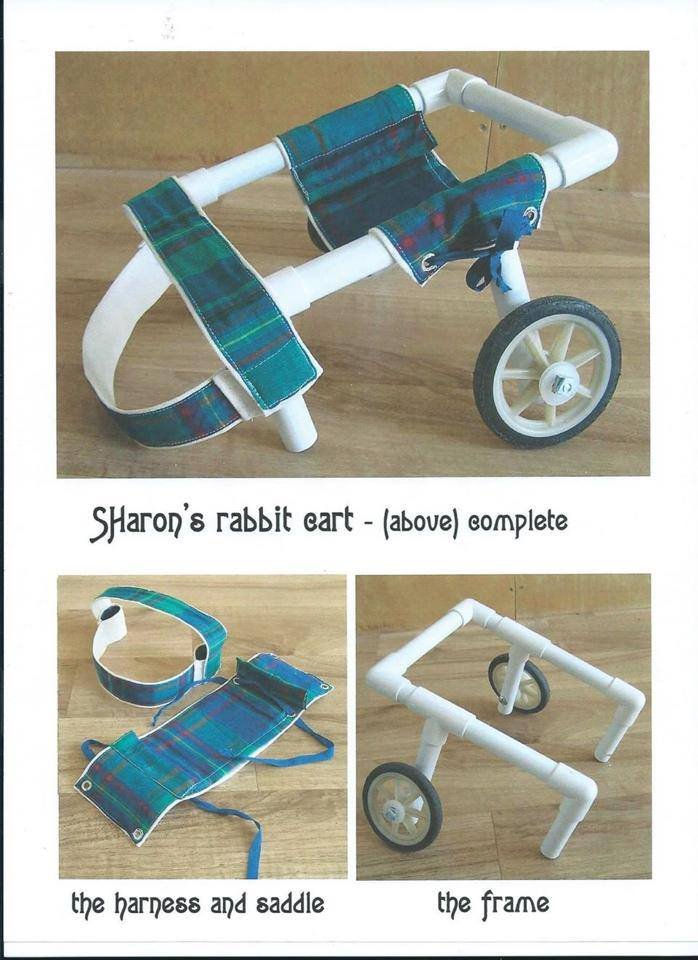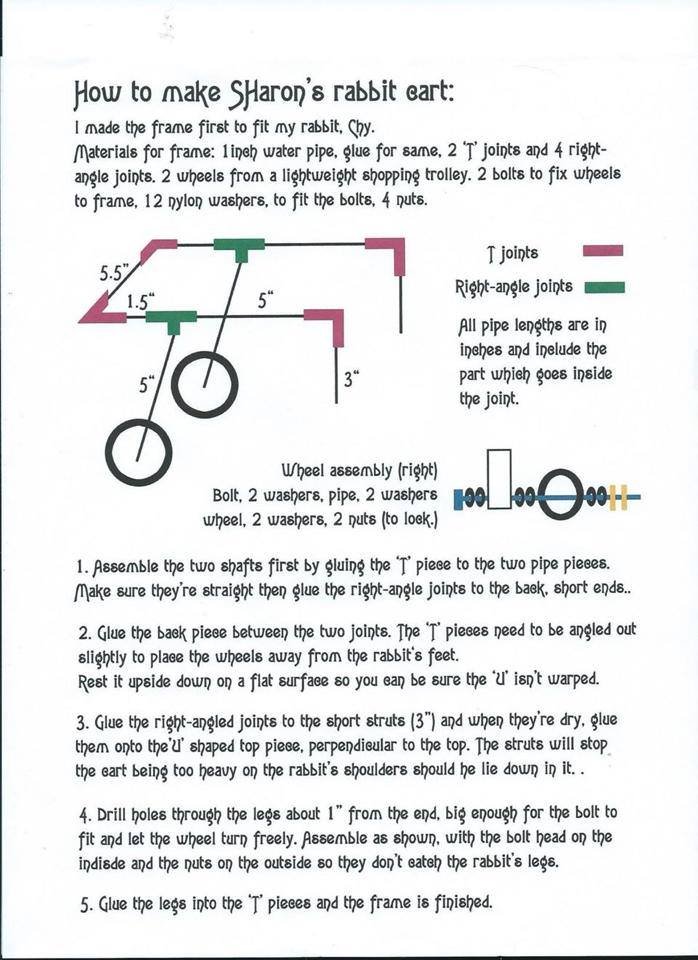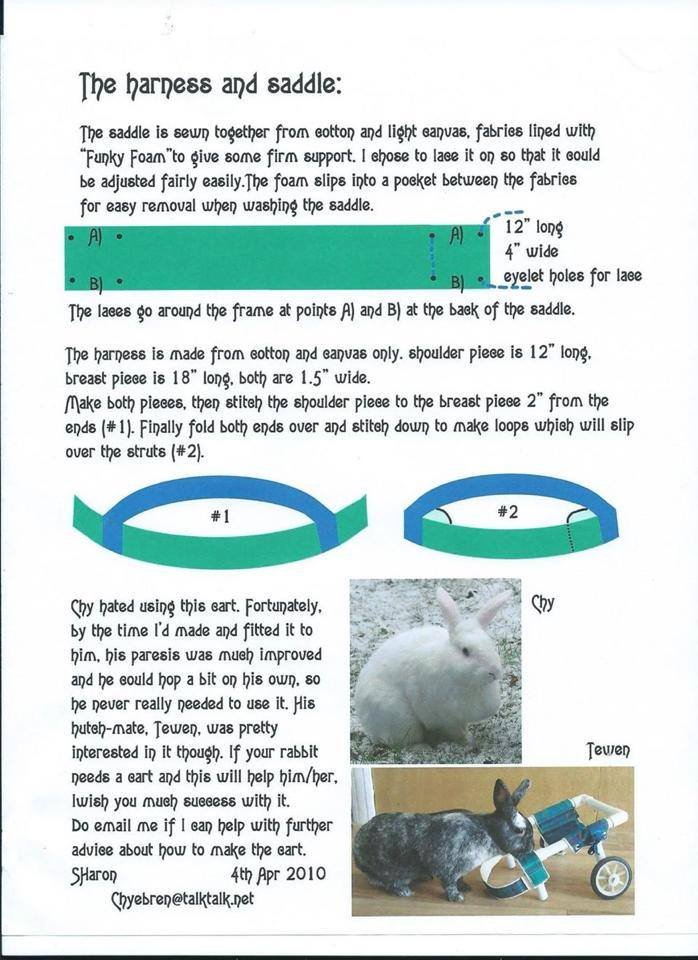Senior & Special Needs Rabbits
Quality of Life
"Quality of life in never an easy topic to discuss, but it is an important one. Owning a disabled rabbit means that we already have physical and oftentimes medical hurdles to face. When do these hurdles become 'too much?' How can we ensure that our rabbit is not suffering? When is it time to let go? These are incredibly difficult questions to answer. As owners, we have to look very objectively at our rabbit's quality of life and be able to assess their happiness, their lifestyle and their prospects for the future to make the best decision possible for them.”
Assessing Quality of Life - Disabled Rabbits
Assessing Injury to Find Appropriate Treatment
“In general, lame rabbits are always a problem. Rabbit bones are brittle and shatter easily so fractures can be complex and difficult to repair.... “
The dilemma of a rabbit with a broken leg - Frances Harcourt-Brown
This website has a wealth of information about Disabled Rabbits
This video is a MUST watch for owners of rabbits that are 4-5 yrs or older.
Senior Rabbits
”Rabbits are considered seniors once they reach about eight years old (though some say a rabbit's senior years begin as young as six years old). Like in humans, a rabbit's needs change as they age. To ensure that your rabbit has a healthy quality of life as they enter their “golden years,” it’s important to understand how their diet, activity, lifestyle, health and environmental needs are changing.”
Special Considerations for Senior Rabbits - Disabled Rabbits
Older rabbits are more prone to illnesses than when they were young. Most rabbits are considered to be “seniors” when they are 5 or more years of age, and these rabbits often have special needs and health care requirements.
Caring for Senior Rabbits - Special Bunny
Even as little as a couple of decades ago, it wasn’t typical to see many senior rabbits. Nowadays with increasingly knowledgeable owners and advancing veterinary care, senior rabbits are a relatively common occurrence.
However, as rabbits age, their needs often change and in order to support our OABs (Old Age Bunnies!), some adjustments to their care are often required.
Feeding and Caring for Senior Rabbits - RWAF
So your little furry friend is getting older... As with any older animals, geriatric critters require an increase in hands on care and observation. Rabbits and guinea pigs are very good at hiding any signs of illness and so it is extra important to spend plenty of time with you bunny or piggie to notice their own unique habits. Changes in behaviour, appetite, urine, faeces or their coat can be an indication of disease in an older rabbit or guinea pig.
Well maintained pet rabbits may live to an age of 8-12 years, and guinea pigs may live up to 8 or 9 years. Your furry friend may require some changes to give them the best of their golden years.
Caring for your elderly rabbit or guinea pig! - The Unusual Pet Vets
Hind Limb Problems
Paralysis is defined as loss of the ability to move a body part.
Paresis is defined as slight or partial paralysis. Unfortunately, companion rabbits sometimes suffer paresis of the hind limbs that makes them unable to stand with those legs, and to locomote normally.
Hind Limb Paresis and Paralysis in Rabbits
Paralysis is the loss of the ability to move (and sometimes to feel anything in) a part of the body. Partial or slight paralysis that does not involve a complete loss of use is called paresis. This page will primarily refer to paralysis and/or paresis of the hind legs as this is the most common form of paralysis in rabbits.
Paralysis in Rabbits - Disabled Rabbits
Splay Leg
Splay leg is a developmental musculoskeletal condition in which a rabbit lacks the ability to adduct one or more of their limbs. In other words, a limb sticks out to the side and the rabbit cannot retract it towards or extend it away from their body.
Splay Leg in Rabbits - Disabled Rabbits
Some rabbits are born with a condition known as "splay-leg," in which the front legs, hind legs or all four legs splay out to the side like little seal flippers. Although most experts believe that the condition is congenital (possibly due to genetics resulting in weak connective tissue), it can be exacerbated by environmental conditions, such as being raised on a slippery floor that gives no traction. A 100% cotton, textured bathmat surface for playing and exercising as soon as babies come out of the nest may help reduce the incidence of splay-leg.
Bracing a Rabbit with "Splay-leg"
Dealing with Urine Scald Caused by Disability
Urine scald occurs when urine is left to soak on a rabbit's body, causing severe urine burn, skin inflammation and hair loss.
There is detailed information in the Urine Scald file
Topical Treatment Options
The following products listed in some sources and elsewhere on the internet are not available in NZ or may not be safe to use -
* A&D Original Ointment
* Neosporin Original
* Heal-X
* Panalog
* Rescue Cream
* Bag Balm
* Sudocrem - Although terrific for healing sore skin, it’s not recommended due to its high Zinc content which can be toxic if ingested. Ok if rabbit cannot reach it to ingest it.
Some Options that are available in New Zealand
* Westley’s World Bunny Balms - These natural balms are especially formulated to help heal and protect vulnerable skin. Useful for sore hocks, urine/rain scald and minor wounds.
* Flamazine (Silvadine equivalent) - topical cream that is soothing and excellent as an antibiotic agent and great for minor cuts or dermatitis issues. This is available from Pharmacies.
* Cavilon - A concentrated barrier cream that provides durable, long-lasting protection from body fluids while also moisturising the skin. The cream vanishes into the skin. Good to put on once Flamazine is absorbed to protect the skin from becoming wet. Cavilon is available from Pharmacies.
* Veterinus Derma Gel - Swiss Formula with a barrier effect for the treatment of minor skin conditions. Promotes fast skin and wound healing
Veterinus Derma Gel
* A recipe for a cream that helps treat urine burn in rabbits
Bathing and Cleaning to Prevent and Address Urine Scald
While not often recommended for healthy rabbits, cleaning and various forms of bathing become necessary and commonplace in the world of disabled rabbits. Disabled rabbits often have issues with maintaining cleanliness. This link this demonstrate how to safely clean your bun's butt if this is necessary.
Baths and Cleaning - Disabled Rabbits
Wheelchairs for Rabbits
A wheelchair can give a rabbit the ability to walk again. It can encourage and facilitate exercise and help to make them stronger. It can give them back that very important sense of freedom and independence and help to lift their spirits.
Wheelchairs and the Disabled Rabbit - Disabled Rabbits
Rabbit Cart Tutorial



Lift Harnesses and Slings
These can help you rabbit feel like they are moving under their own steam and give them a sense of normalcy. Good for out on the grass enrichment and time out of their confined/special set up. Various slings and harnesses can be used.
HelpEmUp Harness
Head Tilt
Head tilt, also known as wry neck or torticollis, is a condition in which a rabbit's head tilts sideways.
Head Tilt in Rabbits - Disabled Rabbits
See our EC / Head Tilt / Torticollis file for more information
Arthritis
Arthritis (osteoarthritis is most commonly seen in rabbits) is inflammation of the joints. It’s a very painful condition. It’s something we might expect to see in older rabbits but in fact they can suffer from it when they’re still quite young. It’s likely that any rabbit over 6 will have some arthritis, but it may be present even in 2 year olds.
Arthritis in Rabbits - RWAF
What is Arthritis - Disabled Rabbits
See our Arthritis file for more information
Limb Loss/Amputation
Limb loss refers to the amputation (surgical or otherwise) of one or more of a rabbit's limbs. Most rabbits who are missing limbs are missing only one, so this page primarily refers to those "tri-pawed" bunnies.
Limb Loss in Rabbits - Disabled Rabbits
Physical Therapy
Physical therapy involves the use of strength-building techniques and exercise to combat a disability. For disabled rabbits, physical therapy has the ability to provide both physical and emotional benefits that can truly make a positive difference in their lives.
Physical Therapy - Disabled Rabbits
Massage
Massage is a touch technique that is used to maintain and enhance health and well being. For disabled rabbits, massage has the ability to provide both physical and emotional benefits that can truly make a positive difference in their lives.
How Can Massage Benefit the Disabled Rabbit? - Disabled Rabbits
Deepening the Bond: How to Connect with Your Rabbit through Massage - House Rabbit Society
Blindness
Blindness is a condition characterised by the limited or complete loss of a rabbit's eyesight.
Blindness in Rabbits - Disabled Rabbits
Enucleation - removal of one or both eyes
RA&SNZ group member Tamas Desci shares his experience - we had a one-eyed bunny who also lost the eye for a nasty abscess. In our case his first five days after surgery was full-on after-care with pain meds 3xdaily, syringe feeding critical care every 2 hours, after that he started eating again and gradually got back to strength. He needed a second (lot easier surgery to clean the eye socket something like two-three weeks in, but apart from that the eye healed well). Antibiotics injections daily for a month. (In our case he continued for a whole year and more due to another infection in lower jawbone.)
Surprisingly he got on really well with one eye only, I'd say he only bumped into things until his whiskers grew back (about two months maybe). He was zooming, binkying and jumping on couches with one eye.
As for the fur, it grew back in patches first, and his face was covered fully in fur in about 3-4 months after surgery.
We named him Capt'n Couscous for he earned his title with his battle scars, looking like a badass pirate.
Red Eye Scanning
Many aspects of how rabbits are put together are a mystery to the people who have them. This article is to help unravel one of those mysteries for you, a rabbit’s vision.
Red Eyes, Eye Scanning & Rabbit Vision - The Bunny Guy
See here for more information - Vision
Deafness
A really important thing with deaf animals is to avoid startling them, especially rabbits as they don’t cope well with fright. So always approach slowly and in their line of vision, keeping in mind that rabbits don’t see too well exactly front on. Using vibration to alert plus the lights at night - use the lights (flick them on and off) to tell him when were coming so they don’t get a big fright every someone enters a room. A good way to confirm they’re deaf is stand just out of sight (behind a door works) and make a loud noise like a whistle or yelp and look for any reaction.
How can you be deaf with ears like That? - The Buckeye House Rabbit Society
Special Needs Housing
The right housing and bedding can make all the difference to your special needs bunny…and can make your life a lot easier as you care for your special pet.
How to house your special needs or disabled bunny rabbit - Special Bunny
Keeping Special Needs Buns Warm
Normal rabbit body temperature ranges from 101°F to 103°F. Maintaining a healthy temperature is important because rabbits can suffer easily from heat stroke if they are allowed to get too hot, hypothermia if they are allowed to get too cold.
Warmth - Disabled Rabbits
